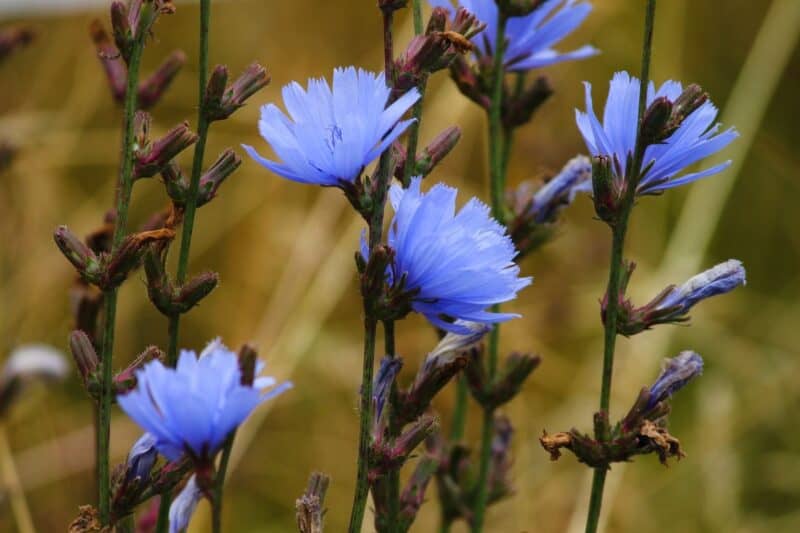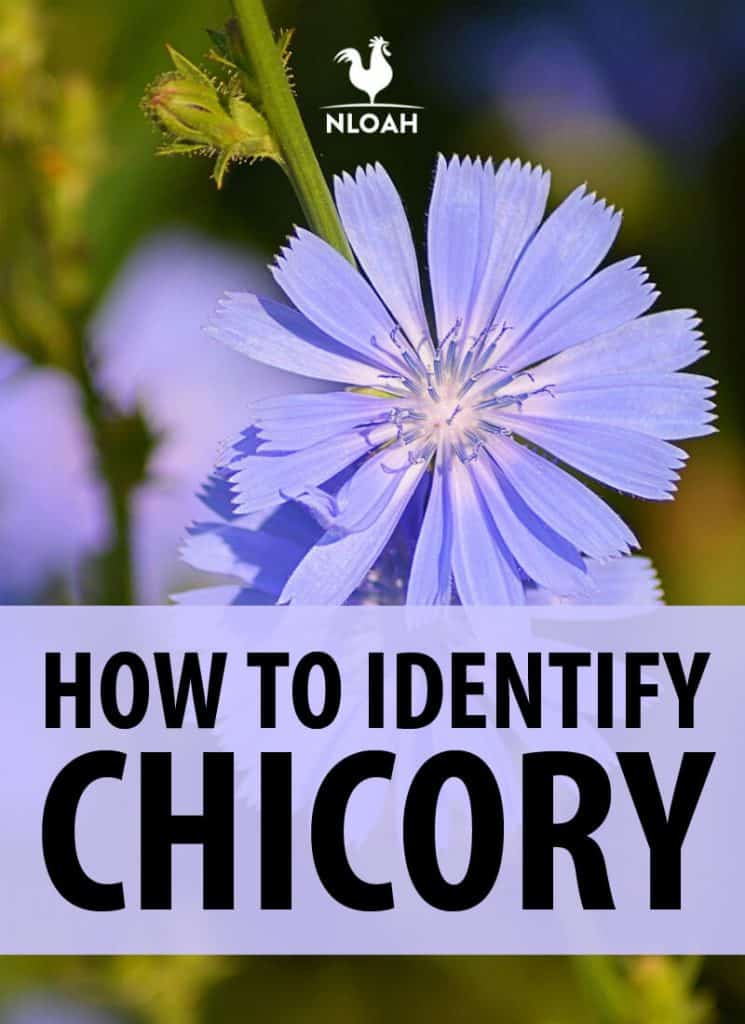Chicory (Cichorium intybus) is probably the easiest of nearly all wild “weeds” to identify. Only daisies and dandelions might be simpler to safely identify for a novice wildcrafter.
Not only are the flowers quite distinctive on a chicory plant, but it has no toxic look-alikes, as Queen Anne’s Lace and so many other plants do.
For centuries, the chicory plant has been used as both a coffee substitute and additive. This beautiful weed has also been heralded for its potential healing properties. When taking as a natural herbal remedy, chicory is typically consumed as either a coffee or a tea.

Chicory Benefits
The potential health benefits of consuming chicory or using it topically have not been evaluated by the Food and Drug Administration – FDA. Products made from chicory are not intended to diagnose, treat, cure, or prevent any disease.
Because the taproot of the chicory plant is bitter, it may boast more health benefits than other parts of the plant – especially where inulin is concerned. Inulin may help with appetite management, keeping blood sugar levels in proper balance, help with digestion, and detox the body.
Most edible and medicinal recipes that include chicory in the ingredients call for the roasted taproot. The exposure to heat during the roasting process can reduce the amount of inulin in contains.
Bitter plants and herbs often tend to have both a cooling and drying impact on the body, which may be beneficial in treating liver, stagnant lymph, congestion, and blood issues.
Chicory Identification When Foraging
Chicory is a perennial wild plant. It reproduces by scattering its seeds each fall so new plants can grow the following year. It blooms typically from July through the middle of October in most environments. Chicory plants generally grow between two to five feet tall.
So what does it look like?
Well, the beautiful and dainty flowers on chicory plants are blue to purple in shade most of the time, but some varieties boast pink or white flowers.
Chicory plants are “cousins” to dandelions, but the petals on the flowers are distinctly different, and no version of the plant comes in a yellow shade. The main shared characteristic between the two beneficial weeds is the long taproot each possesses.
Flowers on a chicory plant both open and close on a daily basis. In the early morning hours the flower heads open up with the sun, but around 10 am to noon, as the sun gets more intense, the flowers close.
Each daily only some of the flowers open, it is as if the plant is taking turns both garnering sunshine and protecting itself from the heat.
- Chicory plants begin as a rosette in the early spring. The basal leaves on the rosette area toothed shaped.
- As the growing season moves along, a leafless and sturdy stem grows from the rosette.
- Just the bottom portion of the is hairy, the rest of the stem is free from any coloration or hair.
- The leaves on a chicory plant are small and scattered sparsely along the stalks.
- When the plants are young, the leaves are largely considered to be either oval or egg shaped.
- Young leaves are a more pale shade of green than they are as they strive to reach maturity, and have a somewhat shiny texture.
- Chicory plants have a bush shape to some degree. Each plant boasts multiple thin branches. If you harvested a chicory plant, you would essentially be holding an entire bouquet in your hand.
- Stalks on chicory plants range in size from one to one and a half inches in diameter as they widen near the flower head.
- Axils begin developing on the leaves during the mid-summer.
- The ground level leaves on chicory plants are approximately 3 to 6 inches long.
- The tiny plant leaves appear to alternate as your eye travels up and down the stem. They are only one inch long, typically.
- Taproots on chicory hold a milky liquid that has a distinctly bitter taste and it commonly referred to as the plant’s juice. The root on domesticated chicory plants are much thinner than those on wild plants.
- Each chicory plant flower head can house as many as 20 petals.
- The ends of the flower petals boast a fringed look, much like that on the end of a scarf.
- Chicory plant leaves are flat and oblong in shape. Roughly 3,000 seeds exist on every plant.
Where to Forage for Chicory Plants
Chicory is not very picky about the soil that it lives in. On our 56-acre rural homestead we have a copious amount of plants growing in primarily clay soil – and thriving. You will almost always discover wild chicory plants growing in full sun areas, often on the edges of livestock pastures, or in roadside ditches.
Chicory does not mind growing in rocky soil or exceptionally thick and tough dirt. They do prefer lime rich soil, especially that which also boasts a pH balance of about 5.8 to 6.5.
This wild plant is exceptionally cold hardy, and is found or cultivated in nearly all 50 states.
Chicory Foraging Tips
Always make certain that chicory plants (and any plant) harvested anywhere but your own property will not get you in trouble for trespassing, and have not been exposed to chemical herbicides or pesticides.
A good rule of thumb is never to forage for wild edibles or medicinals any closer than 200 feet from a roadway due to the likelihood that the local municipality has sprayed that right of way area to kill weeds.
Follow proper sustainable practices when foraging. If you are harvesting the wild chicory for the root before it has gone to seed, removing the entire plant will ensure that none will grow back in the spot the following year.
Although it is difficult to preserve the longevity of a foraged chicory plant when harvesting the entire thing for the taproot, it can be possible.
Only harvest the chicory plant after it has gone to seed. This often foraged plant spreads its seeds both easily and quickly in the fall.
When foraging chicory, only harvest about one-third of the stand.
Next, replant the top of the root crown back into the soil to help increase the chances that it can disperse any remaining seeds, and come back again next year. All that may be needed for chicory to continue growing is a tiny bit of both the taproot and crown tip to still be attached.
How to Harvest Chicory Plants
Roots and Stems
Harvesting of the stems and roots of chicory plants should be undertaken during either the spring when they are young or in the fall when the taproots are fully mature. The heat from the summer sun can cause a bitter taste when roots are harvested at this time.
Flowers
Harvest flowers from chicory plants during the late summer to early weeks of fall to catch the flower heads when they are in full bloom.
Leaves
It is best to harvest leaves from the plant when they are young because raw leaves develop a far more bitter taste as they mature.
Seeds
If you want to harvest seeds from a chicory plant to preserve for the next growing season, do so during the latter days of summer or at the very latest, during the early weeks of fall. By the middle of October the plant goes to seed and begins to naturally disperse the seeds.
When foraging chicory for the seeds, use tweezers to scoop out the ones that gather in tiny clusters between the leaves in pods. Seeds from a chicory plant, gather them in small clusters from in between leaf bunches.
To harvest the taproot, start digging about four to five inches from the center of the chicory plant to ensure you are not going to disturb the taproot during the harvesting process.
If you nick the root with the shovel or garden trowel, it will be more difficult to preserve and more debris will get into the root that will need to be gently scrubbed away.
Preserving the Foraged Plants
Cleaning the taproot of a chicory plant takes at least five minutes to clean after soaking it for at least that long in lukewarm water.
To roast chicory root to make coffee or tea, chop it up into 1 inch bits after cutting it free at the crown area which separates it from the plant stem. Next, place the root bits on an ungreased baking sheet and place them in a 170 degree F (76 C) oven for approximately 5 to 7 hours – or in a dehydrator on the herbs and nut setting for a similar amount of time.
A thoroughly dried root will no longer be pliable and feel coarse and stiff to the touch.
Do not freeze either the stems or the leaves from the plants because this can vastly alter their flavor, and cause them to lose vital nutrients.
It’s far better to dehydrate and then powder these parts to preserve them for future use. Both the leaves and the stems can be washed in cold water and then stored in the refrigerator for approximately 10 days.
To preserve the entire foraged chicory plant, hang dry them in a cool, dry place that does not garner direct sunlight just as you would herbs. The drying area must be ventilated well to prevent the chicory plant from being exposed to too much moisture that can cause it to mold and mildew.
The attractive and dainty chicory flowers can also be dried in an oven, dehydrator, or microwave to preserve them for use in wreaths and other crafts.
Chicory is an easy plant to forage, harvest, and preserve. Not only is the plant easy to identify for novice wildcrafters, but it also does not require hiking over any rugged terrain, or to go deep into the woods and weeds to locate.
While the plants do not actually grow in a patch, if you find one there are likely at least 5 or 6 more growing within a stone’s throw of your first exciting discovery. And if you can’t find any chicory at all, you can always grow it on your own – it’s super easy!


Tara lives on a 56 acres farm in the Appalachian Mountains, where she faces homesteading and farming challenges every single day, raising chickens, goats, horses, and tons of vegetables. She’s an expert in all sorts of homesteading skills such as hide tanning, doll making, tree tapping, and many more.

Tara, I read many of your articles and appreciate them all. You give lots of useful info on ways of the old timers (like my grandparents who have now passed and can no longer advise me). It is easy to follow your instructions. Thank you for passing on this kind of info.
ciao/ca
Tara
Very good article. My wife and I live in east tn. I’ve not looked around this place for chicory but our son and his wife live about 3 miles from us and I’ve heard them comment about having it on their place. We do a lot of gardening and I do blacksmithing and knifemakeing, raise goats, you name it because we’re just old timers and like to be as independent as possible. Thank you for a well written article.